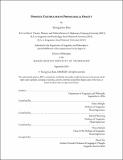Phonetic Faithfulness in Phonological Opacity
Author(s)
Kim, Yeong-Joon
DownloadThesis PDF (20.20Mb)
Advisor
Albright, Adam
Flemming, Edward
Steriade, Donca
Terms of use
Metadata
Show full item recordAbstract
This dissertation presents a novel approach to phonological opacity, which is grounded in new findings regarding substantive restrictions on the patterns of opaque interactions. The central thesis posits that phonological opacity functions to preserve the phonetic properties specified in the input of a phonological operation. Specifically, it argues that inputs are enriched with phonetic auditory features, and surface opacity emerges as a result of processing these enriched inputs. This proposal can be detailed as follows. First, processes that become opaque are initially biased by certain phonetic markedness conditions. Second, these phonetic biases, encoded in the phonetically enriched inputs, are mapped onto the nearest phonologically contrastive sounds to satisfy the requirement of phonetic faithfulness, resulting in surface phonological opacity.
This hypothesis yields a testable prediction: only phonetically natural processes, which possess an appropriate phonetic markedness condition, can become opaque. The results of typological surveys encompassing 87 counterfeeding and 65 counterbleeding interactions across languages support this prediction, revealing that opacified processes are subject to a narrow range of markedness conditions, such as coarticulatory assimilation (e.g., palatalization) and durational adjustments (e.g., segmental weakening). Other types of phonological processes, particularly non-natural ones, are only rarely, if ever, opacified. This asymmetry in the patterns of phonological opacity underscores that opaque interactions are not independent of phonetic substance.
In addition to this main finding, it is also shown that the current proposal offers additional advantages in explaining phonological opacity. First, it successfully accounts for various non-typical opaque interactions such as feeding opacity and stress misapplications, alongside counterfeeding and counterbleeding interactions. The proposal also integrates various phonological phenomena, such as compensatory lengthening, coalescence, and incomplete neutralization, within the framework. Second, learning simulations using a weighted constraint version of the proposed model demonstrate that intermediate hidden structures, such as phonetically enriched inputs, can be learned when the mappings between abstract inputs and surface representations are established.
Date issued
2024-09Department
Massachusetts Institute of Technology. Department of Linguistics and PhilosophyPublisher
Massachusetts Institute of Technology